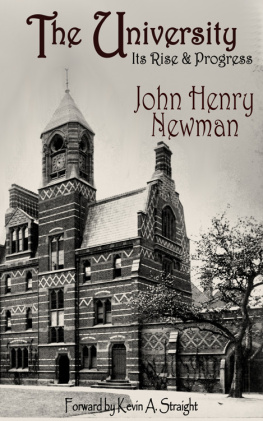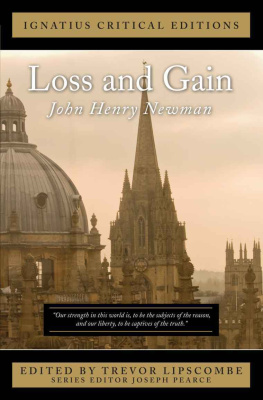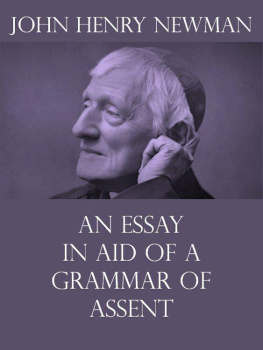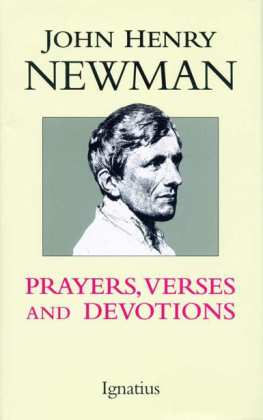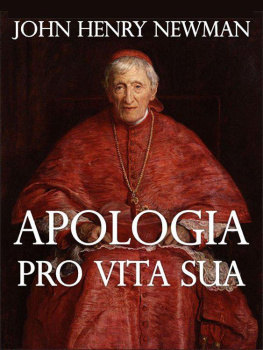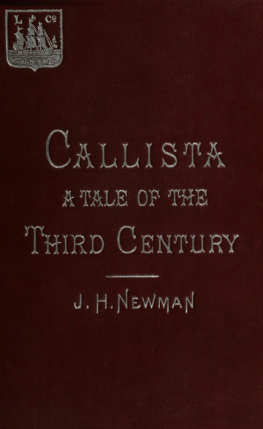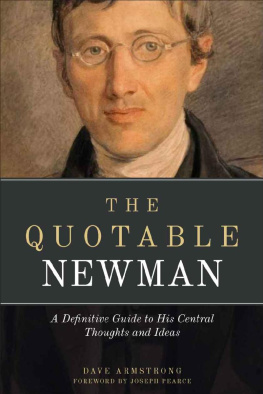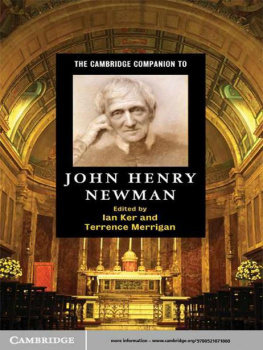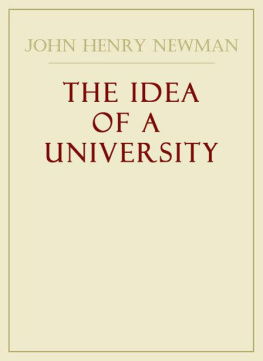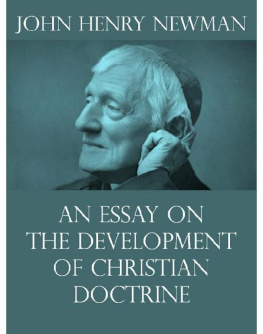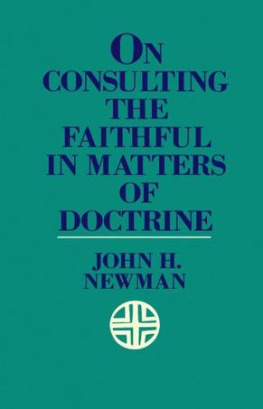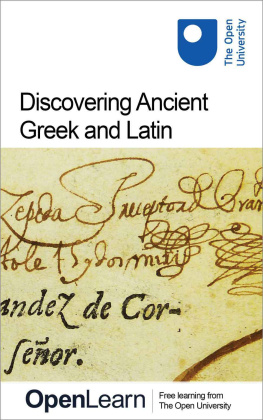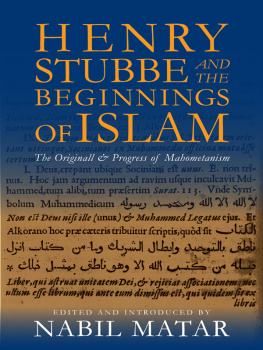Forward
It is no easy task to sum up the life of one of the towering figures of 19thcentury Christianity. John Henry Newman (1801-1890) was at various times apublic scholar, evangelical preacher, crusader for reform in the Church ofEngland, Roman Catholic Cardinal, founder of one of the worlds greatuniversities, and beloved pastor. During his life he wrote around 40book-length works, demonstrating a breadth of scholarship and elegance ofexpository prose that has rarely been equaled. Schools and university studentcenters throughout the English speaking world bear his name. The RomanCatholic Church lacks documentation of only one more miracle to canonize him. Andyet the man himself, despite his undeniable charisma and intellectual force,was humble and unimposing. As a youth he had been slender and bookish, withlittle interest or skill in school athletics. As a grown man he had thegentile ways and the mild, unused, ascetic face [] ofthe Oxford Don which, for a number of years, he was.
I first met John Henry Newman in the library stacks at the University ofIdaho. It was there, as a bored undergraduate, that I encountered a collectionof his tracts, written to champion the Oxford Movement (1833-1845). Themovement, which called for a return to Roman Catholic traditions within theAnglican Church, was deep personal interest to me. I had been raised RomanCatholic but found it increasingly difficult to support the church's positionson homosexuality, family planning, and the ordination of women. Like manybefore me I had found my way to the local Episcopalian church (the Americanbranch of the Anglican Communion), which offered a liturgy nearly indistinguishablefrom the Roman mass without what I perceived as the reactionaryauthoritarianism of the Roman Church. I was seriously considering converting.
It was only after reading Newman, the most visible spokesman and chief propagandistof the Oxford Movement, that I realized how this had come to be. According tohim, the Anglican Church was the third branch of Catholicism, after the Romanand Orthodox churches. Anglicans were embarked on a theological via media("middle road") between Protestantism and orthodox Roman Catholicism.Unlike most protestant denominations, Anglicans had maintained apostolicsuccession: every Anglican bishop could trace his ordination from a line backto a Roman bishop, who could in turn trace his line back to one of the originalapostles. Furthermore, the differences between the faiths were minor andrevolved mainly around whether the pope was the earthly head of the church ormerely another equal among the bishops. All of these were theories I could accept.Three years later I was received into the Episcopalian church, where I havehappily been ever since. Nor am I alone; the Episcopalian denomination containsa sizable minority of members, and even a few priests, who used to be RomanCatholic []. Nothing like this could have been possiblebefore the Oxford movement brought Anglicanism back into the catholicmainstream.
Meanwhile, over the past century the branches of the catholic tree havesprouted a few more sticks: the Anglican Catholic Church, Anglican Church inAmerica, and Anglican Church in North America are some of the offshoots of theAnglican Church, while the Old Catholic Church and Pius X Catholics havesprouted from the main Roman Catholic Church. All of them consider themselves,on some level, to be legitimate parts of the Catholic Church. According toNewman's early writings, they are right.
As he read ever deeper into church history, however, Newman was forced torevise his opinion. He came to the conclusion that, while Anglicans might wellbe Catholics, the only legitimate head of the Catholic faith was the Pope inRome. Too much of a philosopher not to put his conclusion into action once hehad proved it to his satisfaction, he left the Anglican Church in 1845 and wasreceived as a Roman Catholic. While his Anglican allies felt betrayed by thisdefection, I prefer to think of it as a hopeful sign that a final reconciliationis possible between the various parts of Catholicism. To see the path there,though, takes the wisdom of a John Henry Newman.
Newman was an unusually prolific writer throughout his long life. Such anintellect as his could not limit itself to one subject, even so fascinating asubject as Theology. Topics nearly as dear to him were the theory of theuniversity and its history. Much of his theory is contained in The Idea ofthe University, a collection of lectures given in the 1850's while he wasrector of The Catholic University of Dublin (now known as University College,Dublin). The present work, which is mainly concerned with the history ofuniversities, began as a series of newspaper articles in 1854 and was publishedin book form in 1856 under the title Office and Work of Universities. It later appeared in Newmans three volume omnibus Historical Sketchesin 1872.
Newman's theory of the ideal university was heavily influenced by theOxford-Cambridge (Oxbridge) model with which he was most familiar, and which hetended to see as the crowning pinnacle of thousands of years of history. Inthis model the fundamental unit is the college, in which tutors from variousdisciplines work with relatively small groups of students to impart a generalizedliberal education. At the same time, however, Newman recognized that it wastime for Universities to shift their focus to provide for the educational needsof the growing middle class. He also argued strongly that Theology, as one ofthe fundamental branches of knowledge, should be an integral part of thecurriculum. In his view all philosophy could be grouped into three broad areas:Science, the study of nature, Literature, the study of man in nature, andTheology, the study of the supernatural. To be fully educated, an individual neededto be grounded in all three areas.
Another pillar of his theory was the separation of education and research.Education was the main function of a university whereas pure research couldbest be carried out by scientific academies and similar organizations. Very fewpeople had the character traits required to excel at both research andteaching. Even those who can do both should choose one or the other to avoid anongoing distraction and conflict of interest.
The "Newman Model" of the university was influential for theremainder of the 19th century, particularly in the United Kingdom.It gained little traction on the continent or the Americas, however, where a differentmodel. The so-called "Humboldt Model", named after Wilhelm vonHumboldt of Prussia, called for universities to be organized as functional departmentsunder each discipline. The Humboldt university was a knowledge factory in whichstudents learned by participating in research under the leadership of professorswho were selected primarily for their ability as researchers. During the WorldWars the Humboldt-type universities were seen as giving a technological advantageto the countries in which they existed, particularly Germany and the UnitedStates .

